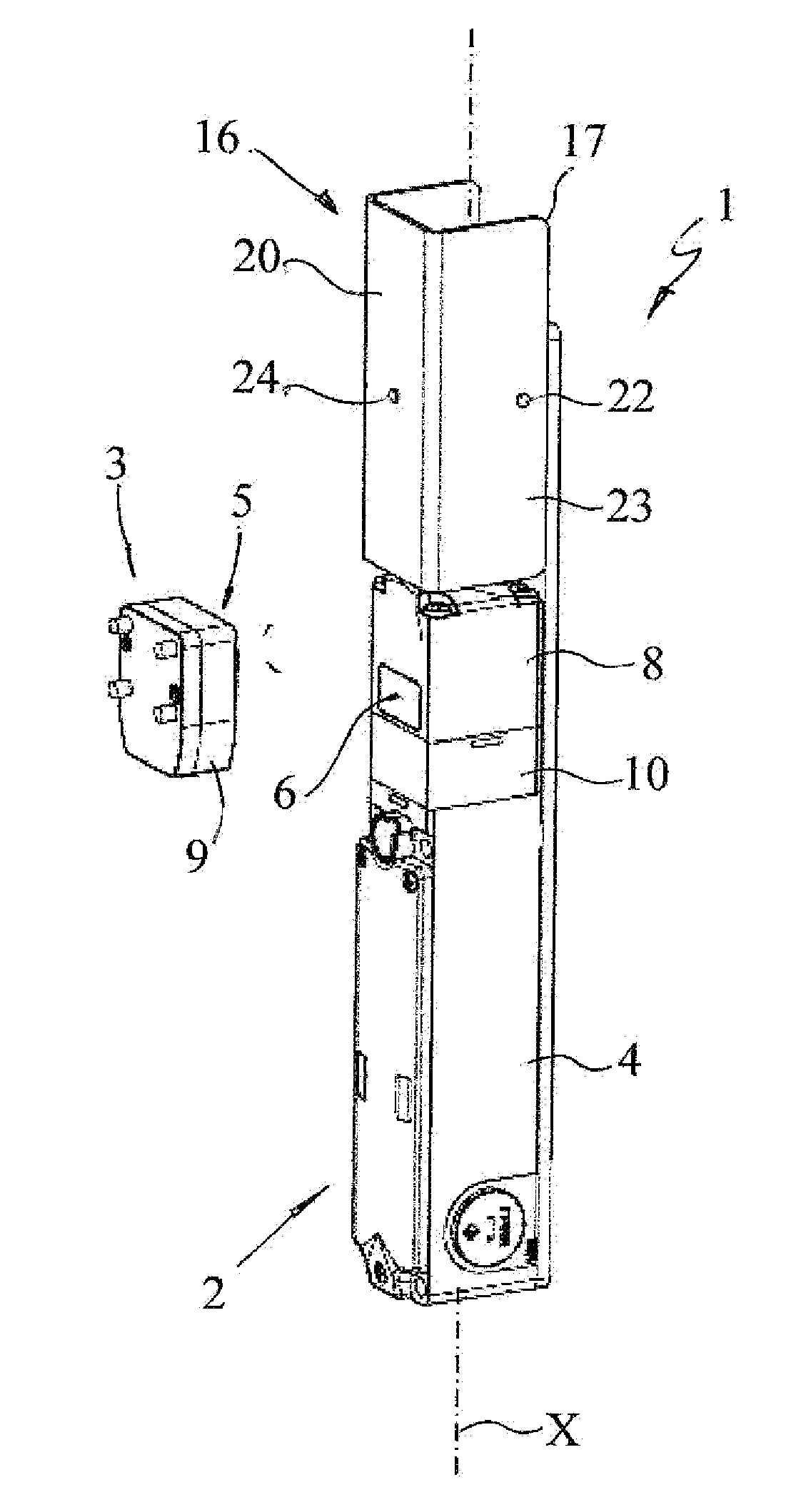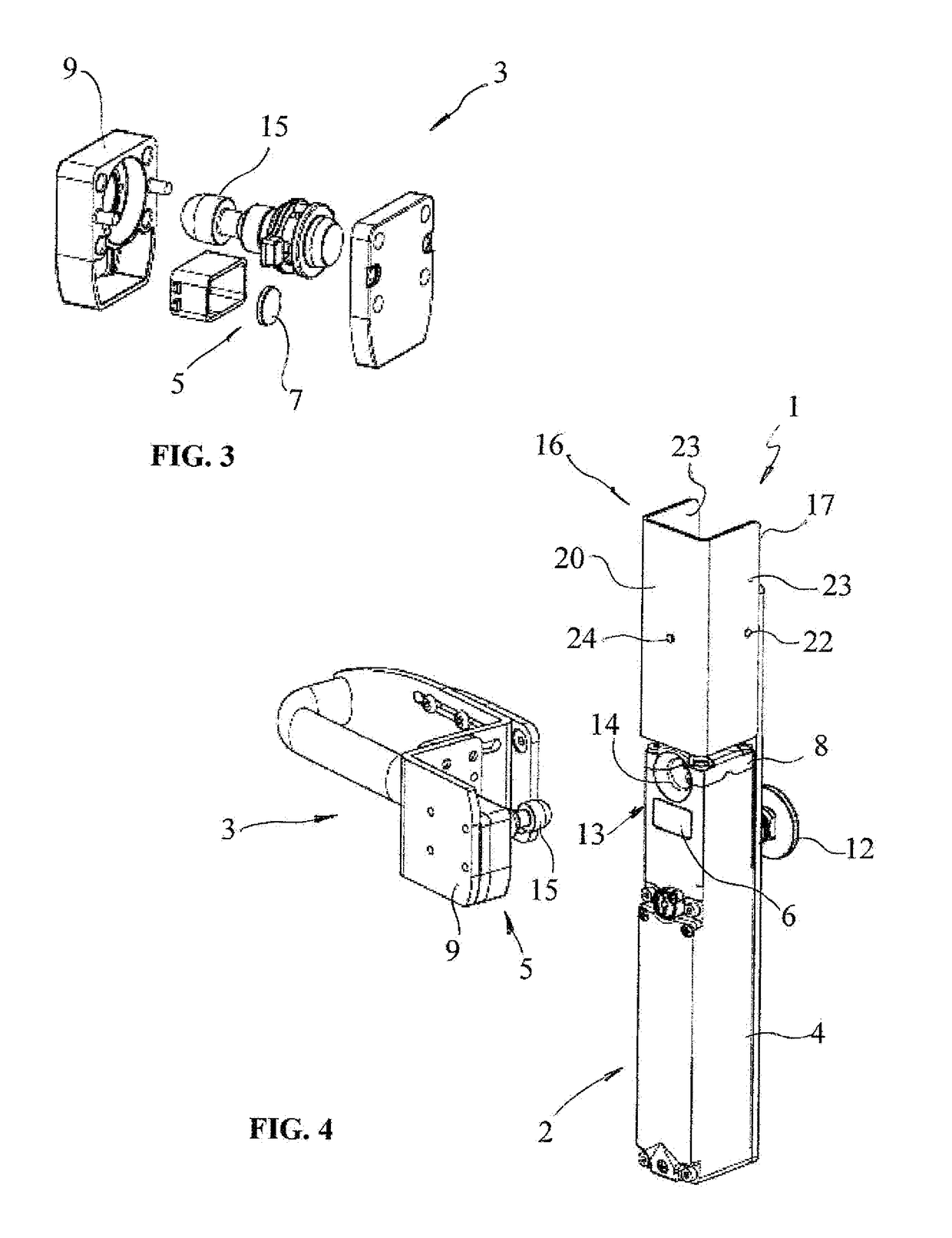Safety Switch with Lock-Out Device
a safety switch and lockout technology, applied in information technology support systems, electrical equipment, sustainable buildings, etc., can solve the problems of not making the switch suitable for applications, not ensuring the complete shielding of the switching unit in every situation, and lack of modularity of the switch, so as to prevent the intervention
- Summary
- Abstract
- Description
- Claims
- Application Information
AI Technical Summary
Benefits of technology
Problems solved by technology
Method used
Image
Examples
first embodiment
[0077]FIG. 1 shows the safety switch, generally indicated by 1, which essentially comprises a switching unit 2 adapted to be anchored to the fixed part of the structure and an operating unit 3 adapted to be anchored to the movable part of the structure. In a known manner the switching unit 2 comprises a box-shaped case 4 defining a longitudinal axis X and housing thereinside switching means adapted to be operatively connected to the power supply circuit of the system to be controlled for the opening / closing thereof and possibly to one or more further control and / or service circuits of the plant for controlling thereof.
[0078]The switching means are not visible from the annexed figures as being of the known type and may be designed according to any of the typical ways for this type of switches, without particular limitations.
[0079]In turn, the operating unit 3 comprises actuating means 5 adapted to interact with the switching means upon closing of the movable part on the fixed part to...
second embodiment
[0092]For example, the mushroom emergency button 12 may be positioned to project toward the inside of the protection so that it can be operated from the inside thereof to cause the stop of the plant in a dangerous situation, as in the case in which an operator remains within the safety perimeter following the closure of the protection with consequent starting of the plant. FIG. 4 shows the switch 1 which differs from that of FIG. 1 mainly in that it comprises centering means 13 associated to both units 2, 3 and adapted to allow an at least partial alignment between the first and second communication element 6, 7 at the time of closure of access.
[0093]In particular, the centering means 13 comprise a centering hole 14 made in the head 8 of the switching unit 2, upperly to the antenna 6, and a centering pin 15 projecting from the box-like shell 9 of the operating unit 3, upperly to the transmitter 7.
[0094]The hole 14 and the centering pin 15 will have the task of aligning in a precise ...
third embodiment
[0116]FIG. 15 shows a third embodiment for the switch 1 substantially similar to that of FIG. 4 and from which it differs, as well as for the presence of two emergency controls 11, 12, for the fact that both the head 8 and the intermediate module 10 of the switch unit 2 are mounted on the case 4 so as to rotate about an axis of rotation R substantially parallel to the longitudinal axis X.
[0117]The head 8 and the intermediate module 10 may rotate separately from each other and the rotation of the head 8 will have mainly the object to vary the angular orientation of the first communication element 6, possibly in a manner integral with the centering hole 14, to keep it always facing the second communication element 7, the position of which depends instead on the open mode of the movable part.
[0118]FIG. 16 shows the same switch 1 of FIG. 15 with the lock-out device 16 inserted but not locked. FIG. 17 shows the switch 1 of FIG. 1 according two additional assembly modes in which the head ...
PUM
 Login to View More
Login to View More Abstract
Description
Claims
Application Information
 Login to View More
Login to View More - R&D
- Intellectual Property
- Life Sciences
- Materials
- Tech Scout
- Unparalleled Data Quality
- Higher Quality Content
- 60% Fewer Hallucinations
Browse by: Latest US Patents, China's latest patents, Technical Efficacy Thesaurus, Application Domain, Technology Topic, Popular Technical Reports.
© 2025 PatSnap. All rights reserved.Legal|Privacy policy|Modern Slavery Act Transparency Statement|Sitemap|About US| Contact US: help@patsnap.com



